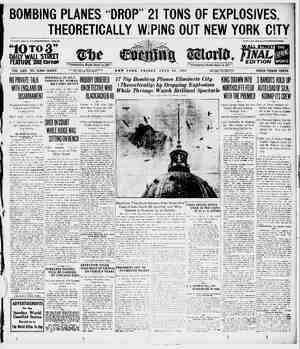The Seattle Star Newspaper, July 29, 1921, Page 8
You have reached the hourly page view limit. Unlock higher limit to our entire archive!
Subscribers enjoy higher page view limit, downloads, and exclusive features.
Gi THE SEATTLE STAR FRIDAY, JULY 29, 1921. OUR PATRONS #° FRIENDS Now that the Skagit bonds have been authorized and the contro- W versy ended we feel free to correct assertions like the following: i “The Pacific Northwest today is in no better position, so far as the shortage of electrical energy is concerned, than is any other part of the United States. Especially is this the case in Western Washington, where at the present time it ] is impossible to obtain electric current from any source in the district, all the steam and hydro-electric plants being loaded to their full capacity, and some current being supplied from British Columbia as well as from the Washington Water Power Company at Spokane.’’---By C. F. Uhden in Journal of Electricity for December 15, 1920. “There is a great scarcity of electric current in Western Washington. In 1919 the Puget Sound district bought 22,000,000 K. W. H. transmitted from Canada and from Spokane. In 1920 this rose to the huge amount of 57,000,000 K. W. H., an amount equal to nearly 60% of the whole City Light output.’’---By J. D. Rossin “Facts About the Skagit.” SUCH MISSTATEMENTS HURT THE COMMUNITY for the reason that INDUSTRIES WILL NOT COME HERE when told they CANNOT GET POWER WITH WHICH TO OPERATE. WE HAVE ADEQUATE POWER FOR ALL PURPOSES AND THAT POWER IS FOR SALE! The accompanying chart shows the power plant capacity, the demand for power and the surplus power plant capacity of this company for the year . i@ 1905 down to the close of the year 1920. fi | More Than | 40,000 : 100.000 : a somo § Horse Power @ 60000 ; More Than 25,000 Horse Power Surplus Surplus. S: Capacity Capacity a in at Close of ‘ 1905 1920 . 19905 1906 1907 1908 1909 1910 191) 1912 1915 1914 1915 1916 1917 - 1918 1919 1920 Our SURPLUS Is Now and Has Been at Almost All Times MORE Than ENOUGH to CARRY the ENTIRE BUSINESS of the SEATTLE MUNICIPAL LIGHTING DEPARTMENT During the war we promised the United States government that we would meet the power requirements of this district. We have ALWAYS DONE this, we are DOING it NOW, and we ALWAYS WILL do it. Our ABILITY to do this, however, HAS BEEN QUESTIONED. Here are the Simple Facts; No Power Comes Into the Seattle District From Canada There is no physical connection between the Seattle District and British Columbia. More than 100 MILES OF TRANSMISSION LINE WOULD HAVE TO BE BUILT before Canadian power could be brought to Seattle. We have a hydro-electric plant and a steam plant in the Bellingham District. In addition we purchased a small block of power from a Cana- sn gam which had more power than it could market in British Co- umbia. WHEN THE DEMAND FOR POWER AT BELLINGHAM IN- CREASES SUFFICIENTLY TO WARRANT CONSTRUCTING AN- OTHER WATER POWER PLANT WE SHALL DO SO ON A SITE WE NOW OWN IN SKAGIT COUNTY. Our system serving the Seattle-Tacoma district is interconnected with the power system of the Washington Water Power Company of Eastern Washington. There is great economic saving in interconnection, and the tendency of the times is toward the creation. of superpower districts by means of interconnected systems, which is a continuation of the growth of central station systems. These INTERCONNECTED SYSTEMS HAVE 2 SS atc ADVANTAGES OVER ISOLATED POWER The City of Seattle could have saved thousands of dollars annually by, accepting OUR OFFER for interconnection with its system. The Milwaukee electrification contract calls for a definite amount of energy from Spokane and from Snoqualmie to be at all times available, and when that energy is not in use pulling trains energy from Spokane sometimes flows into our lines. The BULK of it IS OF NO VALUE TO US and CANNOT BE MADE OF VALUE except to occasionally relieve steam load. For the most part it IS ACTUALLY A WASTE PRODUCT. We receive this surplus energy from time to time, and it is this that is called “importing power from Spokane.” Our plant capacity, shown on the chart above, DOES NOT INCLUDE ANY POWER THAT MAY FLOW INTO OUR LINES through the Mil- waukee Electrification. OUR PLANT CAPACITY IS JUST AS GREAT AND OUR INVEST- MENT IS JUST AS GREAT as if the surplus energy incident to the Mil- waukee electrification did not exist. 4 We ARE NOT LOADED to capacity. We HAVE the POWER. We have ALWAYS HAD the PQWER and we WILL CONTINUE TO HAVE the POWER to MEET ALL your requirements. PUGET SOUND POWER & LIGHT COMPANY








